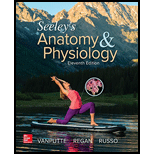
Concept explainers
(a)
To determine:
The arteries that a red blood cell would encounter in the Posterior interventricular groove of the heart if it started in the left ventricle.
Introduction:
In the circulatory system, the heart is a muscular organ that is used to pump blood through blood vessels.
(b)
To determine:
The arteries that a red blood cell would encounter in an Anterior neck to the brain if it started in the left ventricle.
Introduction:
In the nervous system, the brain is the central organ that consists of the cerebrum, brainstem, and cerebellum.It controls all the activities of the body.
(c)
To determine:
The arteries that a red blood cell would encounter in the Posterior neck to the brain if it started in the left ventricle.
Introduction:
Neck is an anatomical structure of the body that connects the head with the trunk to provide the mobility and movement of the head.
(d)
To determine:
The arteries that a red blood cell would encounter in the external skull if it started in the left ventricle.
Introduction:
Skull is a bone framework that covers the brain and provides support to the structureof the face of all the vertebrates.
(e)
To determine:
The arteries that a red blood cell would encounter in the tip of the fingers of the left hand if it started in the left ventricle.
Introduction:
A finger is a limb, and an organ of manipulation and sensation occurs in the hands of humans and all the living organisms.
(f)
To determine:
The arteries that a red blood cell would encounter in the Anterior compartment of the leg if it started in the left ventricle.
Introduction:
Legs are the anatomical structure that is responsible for weight-bearing and locomotion.
(g)
To determine:
The arteries that a red blood cell would encounter in the liver if it started in the left ventricle.
Introduction:
Liver is an organ that used to detoxifies various metabolites, synthesizes proteins, and produce biochemical products for digestion in the body.
(h)
To determine:
The arteries that a red blood cell would encounter in the small intestine if it started in the left ventricle.
Introduction:
Small intestine is an organ present in the gastrointestinal tract where absorption of nutrients and minerals takes place.
(i)
To determine:
The arteries that a red blood cell would encounter in the urinary bladder if started in the left ventricle.
Introduction:
Urinary bladder is a hollow muscular organ that collects and stored urine from the kidney. In humans, the urinary bladder can hold 300-500 mL of urine.
Want to see the full answer?
Check out a sample textbook solution
Chapter 21 Solutions
Seeley's Anatomy & Physiology
- Skryf n kortkuns van die Egyptians pyramids vertel ñ story. Maximum 500 woordearrow_forward1.)What cross will result in half homozygous dominant offspring and half heterozygous offspring? 2.) What cross will result in all heterozygous offspring?arrow_forward1.Steroids like testosterone and estrogen are nonpolar and large (~18 carbons). Steroids diffuse through membranes without transporters. Compare and contrast the remaining substances and circle the three substances that can diffuse through a membrane the fastest, without a transporter. Put a square around the other substance that can also diffuse through a membrane (1000x slower but also without a transporter). Molecule Steroid H+ CO₂ Glucose (C6H12O6) H₂O Na+ N₂ Size (Small/Big) Big Nonpolar/Polar/ Nonpolar lonizedarrow_forward
- what are the answer from the bookarrow_forwardwhat is lung cancer why plants removes liquid water intead water vapoursarrow_forward*Example 2: Tracing the path of an autosomal dominant trait Trait: Neurofibromatosis Forms of the trait: The dominant form is neurofibromatosis, caused by the production of an abnormal form of the protein neurofibromin. Affected individuals show spots of abnormal skin pigmentation and non-cancerous tumors that can interfere with the nervous system and cause blindness. Some tumors can convert to a cancerous form. i The recessive form is a normal protein - in other words, no neurofibromatosis.moovi A typical pedigree for a family that carries neurofibromatosis is shown below. Note that carriers are not indicated with half-colored shapes in this chart. Use the letter "N" to indicate the dominant neurofibromatosis allele, and the letter "n" for the normal allele. Nn nn nn 2 nn Nn A 3 N-arrow_forward
- I want to be a super nutrition guy what u guys like recommend mearrow_forwardPlease finish the chart at the bottom. Some of the answers have been filled in.arrow_forward9. Aerobic respiration of one lipid molecule. The lipid is composed of one glycerol molecule connected to two fatty acid tails. One fatty acid is 12 carbons long and the other fatty acid is 18 carbons long in the figure below. Use the information below to determine how much ATP will be produced from the glycerol part of the lipid. Then, in part B, determine how much ATP is produced from the 2 fatty acids of the lipid. Finally put the NADH and ATP yields together from the glycerol and fatty acids (part A and B) to determine your total number of ATP produced per lipid. Assume no other carbon source is available. 18 carbons fatty acids 12 carbons 9 glycerol A. Glycerol is broken down to glyceraldehyde 3-phosphate, a glycolysis intermediate via the following pathway shown in the figure below. Notice this process costs one ATP but generates one FADH2. Continue generating ATP with glyceraldehyde-3-phosphate using the standard pathway and aerobic respiration. glycerol glycerol-3- phosphate…arrow_forward
 Human Physiology: From Cells to Systems (MindTap ...BiologyISBN:9781285866932Author:Lauralee SherwoodPublisher:Cengage Learning
Human Physiology: From Cells to Systems (MindTap ...BiologyISBN:9781285866932Author:Lauralee SherwoodPublisher:Cengage Learning Human Biology (MindTap Course List)BiologyISBN:9781305112100Author:Cecie Starr, Beverly McMillanPublisher:Cengage Learning
Human Biology (MindTap Course List)BiologyISBN:9781305112100Author:Cecie Starr, Beverly McMillanPublisher:Cengage Learning Fundamentals of Sectional Anatomy: An Imaging App...BiologyISBN:9781133960867Author:Denise L. LazoPublisher:Cengage LearningBasic Clinical Lab Competencies for Respiratory C...NursingISBN:9781285244662Author:WhitePublisher:Cengage
Fundamentals of Sectional Anatomy: An Imaging App...BiologyISBN:9781133960867Author:Denise L. LazoPublisher:Cengage LearningBasic Clinical Lab Competencies for Respiratory C...NursingISBN:9781285244662Author:WhitePublisher:Cengage





